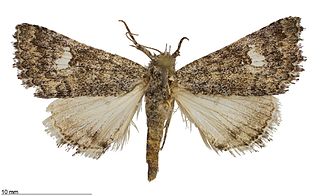
Heteranassa is a monotypic moth genus in the family Erebidae described by J. B. Smith in 1899. Its only species, Heteranassa mima, was first described by Leon F. Harvey in 1876. It is found in warm, arid habitats in North America from California to Texas, northward to Oklahoma, and south as far as Oaxaca in Mexico.
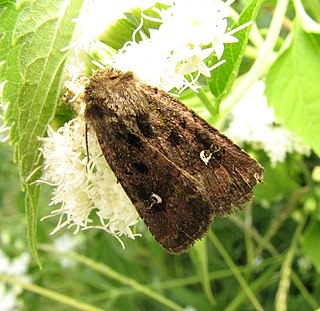
Lacinipolia is a moth genus in the family Noctuidae.

Lacinipolia renigera is a species of moth of the family Noctuidae. The moth flies from May to October depending on the location.
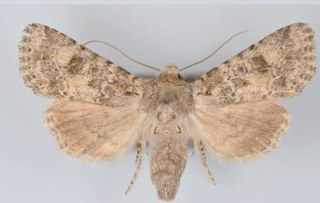
Aseptis catalina is a moth of the family Noctuidae first described by John Bernhardt Smith in 1899. It is found in the deserts of Arizona, California and Baja California in Mexico.

Aseptis characta is a moth of the family Noctuidae first described by Augustus Radcliffe Grote in 1880. It is widespread in western North America, where it is found in the western Great Plains, Great Basin, and Pacific regions from British Columbia, Alberta, and Saskatchewan to Colorado, Utah, northern Arizona and southern California. The species occurs in dry habitats like sagebrush steppe, juniper woodlands, and open forest from sea level to 2,500 meters.

Hypotrix alamosa is a moth of the family Noctuidae first described by William Barnes in 1904. It is known only from the United States in south-eastern Arizona.

The Erebidae are a family of moths in the superfamily Noctuoidea. The family is among the largest families of moths by species count and contains a wide variety of well-known macromoth groups. The family includes the underwings (Catocala); litter moths (Herminiinae); tiger, lichen, and wasp moths (Arctiinae); tussock moths (Lymantriinae), including the arctic woolly bear moth ; fruit-piercing moths ; micronoctuoid moths (Micronoctuini); snout moths (Hypeninae); and zales, though many of these common names can also refer to moths outside the Erebidae. Some of the erebid moths are called owlets.
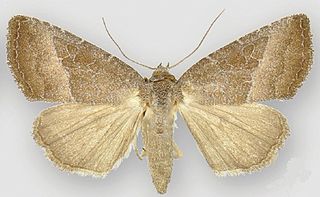
Ogdoconta cinereola, the common pinkband moth, is a moth in the family Noctuidae. It is found in eastern, central, and south-western North America. It occurs from southern Ontario and Quebec south to southern Florida. At the western edge of its distribution, it occurs from Manitoba southward through the Great Plains of Nebraska and Iowa, south throughout most of Texas, and westward through southern New Mexico to south-eastern Arizona. The distribution extends south to the state of Coahuila in northern Mexico.

Drasteria parallela is a moth in the family Erebidae. It is found in the Cascade Mountains of Washington, the Klamath and Siskiyou Mountains of south-western Oregon and the northern Sierra Nevada in California. The habitat consists of exposed ridges in forests at middle elevations.
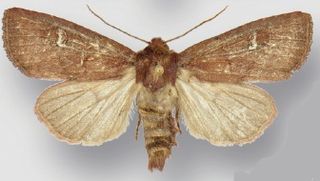
Resapamea angelika is a moth in the family Noctuidae. It only known from the vicinity of Angel Lake in the East Humboldt Range of north-eastern Nevada. The habitat consists of sedge meadows along tributaries of Angel Creek.
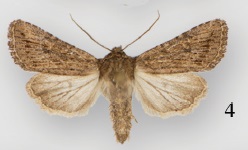
Protorthodes eureka is a moth in the family Noctuidae first described by William Barnes and Foster Hendrickson Benjamin in 1927. It is found in North America from southern Alberta southward in the western Great Plains to Colorado and in the Great Basin to east-central California and south-western Colorado. The habitat consists of open xeric habitats, especially sagebrush prairie and open pinyon-juniper woodlands.

Protorthodes incincta, the banded Quaker moth, is a moth in the family Noctuidae. It is found in North America, where it has been recorded in the western Great Plains and dry open forests of the Rocky Mountain region, with range extensions into the Great Basin, the American Southwest, and eastward in relict prairie areas into the Great Lakes region.

Nudorthodes molino is a moth in the family Noctuidae first described by J. Donald Lafontaine, J. Bruce Walsh and Clifford D. Ferris in 2014. It is found in the western US in southeastern Arizona and southwestern New Mexico.
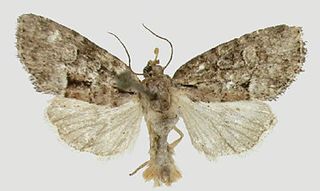
Cherokeea attakullakulla is a moth in the family Noctuidae and the only species in the genus Cherokeea. It is found in North Carolina and Georgia.

Lacinipolia vicina is a moth in the family Noctuidae. It is found in Massachusetts, New York, Pennsylvania, Virginia, North Carolina, New Jersey and possibly Indiana.
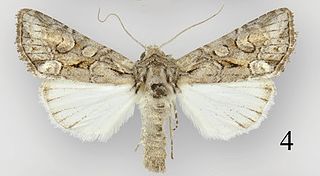
Lacinipolia teligera is a moth in the family Noctuidae. It is found from the Great Plains of central Colorado and eastern Kansas southward to central Texas.
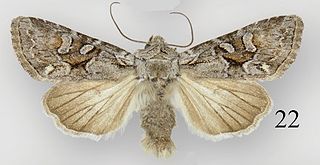
Lacinipolia pensilis is a moth in the family Noctuidae. It is found in the western cordilleran region from central British Columbia and western Alberta southward to at least Washington and central Utah.

Lacinipolia sareta is a moth in the family Noctuidae. It is found throughout western North America, from the southern Yukon and the Northwest Territories to Texas, Arizona and California. It probably also occurs in northern Mexico. It ranges eastward across the southern boreal region to at least Quebec.

Lacinipolia dimocki is a moth in the family Noctuidae. It is found on the eastern slope of the Washington Coast Ranges to southern California.
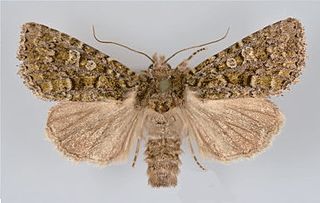
Viridiseptis is a monotypic moth genus in the family Noctuidae erected by Tomas Mustelin and Lars G. Crabo in 2015. Its only species, Viridiseptis marina, was first described by Augustus Radcliffe Grote in 1874. It is found throughout coastal California and in south-western Oregon as far north as Douglas County. It is widely distributed in southern California. It is found in many habitats such as coastal chaparral, mountain forest, mountain-desert transition zone, and occasionally in the deserts from sea level to at least 2000 meters.




















